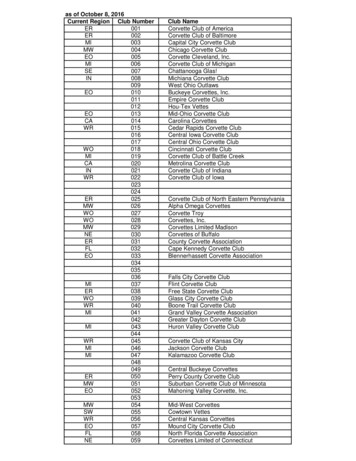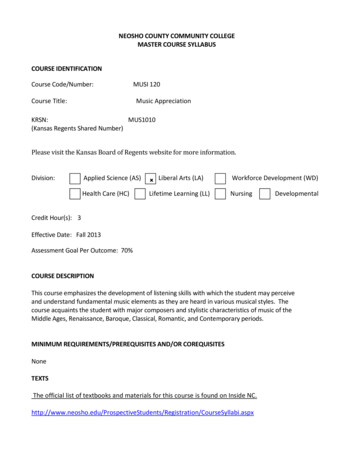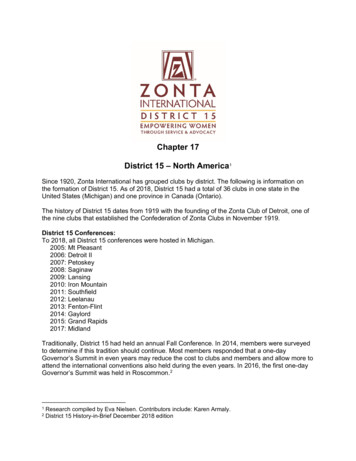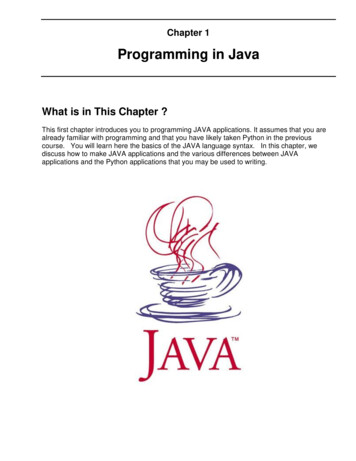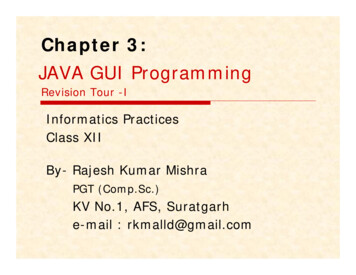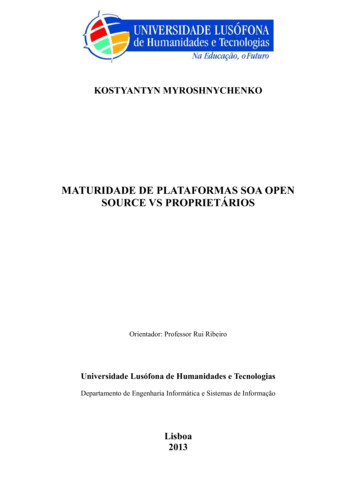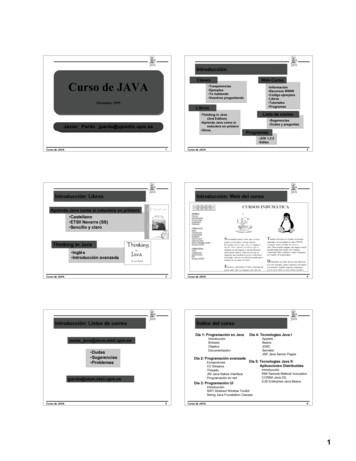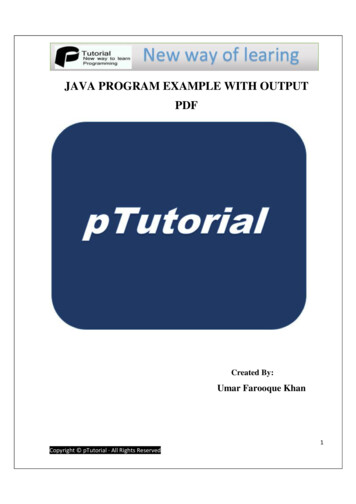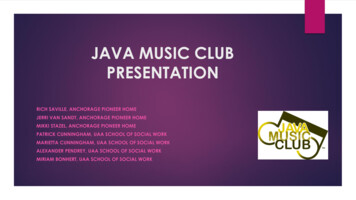
Transcription
JAVA MUSIC CLUBPRESENTATIONRICH SAVILLE, ANCHORAGE PIONEER HOMEJERRI VAN SANDT, ANCHORAGE PIONEER HOMEMIKKI STAZEL, ANCHORAGE PIONEER HOMEPATRICK CUNNINGHAM, UAA SCHOOL OF SOCIAL WORKMARIETTA CUNNINGHAM, UAA SCHOOL OF SOCIAL WORKALEXANDER PENDREY, UAA SCHOOL OF SOCIAL WORKMIRIAM BONHERT, UAA SCHOOL OF SOCIAL WORK
What is the burden of Alzheimer’s disease in theUnited States and Alaska?One of the top 10 leading causes of death in the UnitedStates. The 6TH leading cause of death among US adults. The 5TH leading cause of death among adults aged 65–85 years. The9th leading cause of death inAlaska
U.S. and AlaskaAlzheimer’s Statistics Over 5 million Americans are living with Alzheimer’s and as many as 16 million will havethe disease in 2050. The cost of care is estimated to total 214 billion in 2014, increasing to 1.2 trillion by midcentury. Nearly one in every three seniors who dies each year has Alzheimer’s or anotherdementia. Number of people aged 65 and older with Alzheimer’s by age in AlaskaYear65-7475-8485 50020251,9005,0004,00011,000 2014 Alzheimer’s Association Disease Facts and Figures Report (alz.org/facts)
What is the Java Music Club? The Java Music Club is the first standardized mutual support program addressing thecritical rates of depression and loneliness across the senior living spectrum. It is aresearch-based wellness program for long-term care homes (including memorycare), assisted living and retirement homes, adult day centers and communitysupport centers. Developed by Kristine Theurer, MA (gerontology) MTA (music therapy), over a sixyear period and implemented in 2010, in three nursing homes in British Columbia,Canada. Ms. Theurer drew from her 20 years of experience as an accredited music therapistfacilitating therapeutic groups.
Why is it Unique 1. Peers helping peers. 2. Creates meaning and purpose. 3. The aboriginal talking stick gives courage. 4. Something for everyone. 5. Promotes emotional engagement. 6. A safe place to share.
The ComponentsThe Java Music Club incorporates a mix of easy to use tools to makefacilitating mutual support groups work well for staff, volunteers and evenresidents. No musical abilities are required. The following items are includedwith the care home license:Standard facilitators guideQuotes and poetry52 discussion themes52 large format photographs142 custom recorded songsTraditional “talking stick”Implementation training DVDEvaluation guide and forms
Pilot Project: Java Music Club: MutualSupport for Cognitively Impaired atRisk Adults Research question: Will participation in this program result in mutualsupport among the participants, and increase their quality of life? Hypothesis 1. Participation in the Java Music Club over a year period willresult in higher quality of life than those of the control group. Hypothesis 2. Participation in the Java Music Club over a year period willresult in less reduction in their post test MMSE scores than those of thecontrol group. Hypothesis 3. Participation in the Java Music Club over a year period willresult in less loneliness scores than those of the control group.
Pre and Post Testing Mini-Mental Status Examination (MMSE) Clock Drawing Test (CDT) UCLA Loneliness Scale Sense of Belonging Instrument Alzheimer’s Disease-Related Quality of Life Scale (ADRQL). Measurement of each session will include the use the use Greater CincinnatiChapter Well-Being Observation Tool and an Observation Checklist. Following the completion of the Program the following measurements will beobtained: Client Interview Schedule, a Staff Interview Schedule, and directedfocus groups.
Music Therapy Literature Review Mutual support1 Promotes engagement and participation1Music Therapy2-9 Increases engagement Reduces symptoms Activates brain directlyPerson-centered care6-7, 9, 10 Improves the quality of life Increases the quality of care
5 Reasons Why Music Boosts Brain Activity1.Music evokes emotions that bring memories2.Musical aptitude and appreciation are two of the last remaining abilities indementia patients.3.Music can bring emotional and physical closeness.4.Singing is engaging.5.Music can shift mood, manage stress and stimulate positive interactions.
The Epidemic of Loneliness & DepressionDepression - University of Waterloo (2014) Examined the prevalence of depressivesymptoms of newly admitted residents intolong-term care54.3 cases per 100 residents at assessment—60.8 at 3 month follow-up1Loneliness in Residential Care over half of residents experience loneliness2those with dementia experience a profoundsense of loneliness
Inappropriate Prescribing ofAntipsychotic Medications Residents in long-term care are nowolder, and have more complex needsand dependency Those with dementia express theirunmet needs through repetitiveverbalizations, responsive behaviorsand pacing5 Research indicates that the mostcommon responses are antipsychoticmedications(or ignoring the behavior)5
Mutual/Peer Support“We recognize peer supportas an integral componentof a mental health programfor older adults”US Institute of Medicine (2012)
The Purpose ofJava Memory Care1. To cultivate meaningful emotionalengagement2. To enhance resident to resident interactions3. To reduce loneliness and depression
Why Groups Matter Create a ‘group’ settingwhenever possible Groups strengthen socialidentity and sense ofbelonging8-10 Groups are more effective inalleviating social isolation andloneliness thanone-to-one interventions11
The Step by Step Guide
Step 1 - Facilitator Reads1. “My name is and I thank you for theprivilege of being present here with you.”2. Invites members to take on a role“ , would you consider being ourgroup leader/song leader/quotesreader/wind chime player?”
Step 2 - Opening WelcomeRead by the ‘Group Leader’Welcome everyone to theJava Music Club.We get together to supporteach other and to have fun.We have one guiding principleand that is—loving kindness.Please join me in our opening song.
Step 3 - Opening Song:The Java Memory Care SongA little music keeps me feeling goodA little coffee, like I knew I couldA great big hug and I’m okayI can make it through this day.A little singing would be right on timeA little loving and I’m feeling fineSunshine through my window paneAnd I can make it through this day.Here’s the kind of people I likeOnes that are kind and treat me rightAnd that’s why I think I loveOur little Java Music Club, oh yeahOur little Java Music Club.
Step 4 - Passing a Handshake
Step 5 - Getting Centered
Finding Comfort
Step 6 - Choosing a Theme and Song
Choosing a Song
Getting the Most Out of a Song1. Talk about the lyrics or melodyListening to that song, I feel , because .Listening to that song reminds me to , because .2. Use touch and movementa. Holding their hand, linking your arm with theirsb. Holding their hand and swaying gentlyc. Dancing3. Play a rhythmic instrument with them4. Slow it down – waaaay down (reduces agitation)5. Use a song basket
Step 7 – Show Photographs—Create a StoryEncouragement
Step 8 - Add Movement Choose an upbeat song Add some form of movement Can be as a group, or one at a time Swinging arms (gently) Clapping together Dancing together Marching (on the spot) Hitting a tambourine together
‘Quotes Reader’ Chooses a Quoteo Invite the ‘Quotes Reader’ to chooseo Repeat and examine itEvery day may not be good,but there's something goodin every day.Author Unknown
Closing AffirmationJava Memory CareGroup Leader reads (wind chimes before andafter) I bring love andI am lovedI bring peace andI am at peace
Closing Song:I’ll be there for youMay you have time to rest,And may your fortune be the bestMeet some kindness on your wayand have sunshine most everyday.May you always do your partAnd have a song in your heartAnd may every day be blessedFor I wish you all the best.Enjoy every day don’t forgetLike it’s the last one you’ll getAnd remember this in all you doI’ll be there for you.When you’re lonely or your blueKnow that I will have time for youThrough the cloudy days and rainOur friendship stays the same.And enjoy every day don’t forgetLike it’s the last one you’ll getAnd remember this in all you doI’ll be there for you,I’ll be there for you.
Passing a Hug and Serving Coffee/Treats
Future Plans for Dissemination of ProgramFiscal Year:Amount:Grantee:Project Title:2016 27,400.00Alzheimer’s Resource of AlaskaJava Music Club Pilot: Mutual support for cognitivelyimpaired adultsKristine Theurer, Founder of Java Music Club to visit Anchorage forthree days and host workshops for providers interested in theProgram.Implementation of Java Music Club in the other 5 Pioneer HomesLicenses and material will be provided to each home.Five day training and outcome measures created.Ongoing consultation provided by Kristine Theurer and PatrickCunningham
New Grant Opportunity Identifying Outcome/Evidence-Based Isolation Interventions. To reduce negative health outcomes highly correlated or associated withsocial isolation in low-income or vulnerable individuals 50 and older. Submitted a letter of inquiry on behalf of Alzheimer’s Resource of Alaska. Proposed to implement Java Music Club in their Anchorage, Fairbanks,Palmer, and Juneau offices. Population served with be those with mild cognitive impairment and alsooffer it to caregiver support groups.
We wish to thank the UAA Center forCommunity Engagement and Learning forproviding the mini-grant that supported theestablishment of the Java Music Club atthe Anchorage Pioneer Home.THE ENDQUESTIONS AND COMMENTS FROM THEAUDIENCE
ReferencesTheurer, K., Wister, A., Sixsmith, A., Chaudhury, H., Lovegreen, L. (2012). The developmentand process evaluation of mutual support groups in long-term care homes. Journal ofApplied Gerontology, XX(X) 1-29.1Neufeld,E., Freeman, S., Joling, K., & Hirdes, J. P. (2014). "When the golden years are blue":Changes in depressive symptoms over time among new admitted to long term carefacilities. Clinical Gerontologist, 37(3), 298-315. doi: 10.1080/07317115.2014.8859192Nyqvist,F., Cattan, M., Andersson, L., Forsman, A. K., & Gustafson, Y. (2013). Social capitaland loneliness among the very old living at home and in institutional settings. Journal ofAging and Health, 2(1). doi: 10.1177/08982643134975083Cacioppo,J. T., Hughes, M. E., Waite, L. J., Hawkley, L. C., & Thisted, R. A. (2006).Loneliness as a specific risk factor for depressive symptoms: cross-sectional andlongitudinal analyses. Psychology and Aging, 21(1), 140-151.4President’sNew Freedom Commission on Mental Health. (2003). Achieving the promise:Transforming mental health in America: Final report (Vol. DHHS Pub. no.SMA-03-3832).Rockville, MD: DHHS Publication.5Cohen-Mansfield,J. (2013). Nonpharmacologic treatment of behavioral disorders indementia. Current Treatment Options in Neurology, 15(6), 765-785. doi: 10.1007/s11940-0130257-2
References Cont’d6Kitwood,T. 2013. In Care-Giving in Dementia 2: The concept of personhood and its relevance for anew culture of dementia care. Chapter 1.7Riessman,F. (1965). The "Helper therapy" principle. Social Work, 10(2), 27-32.8Finn,L. D., Bishop, B. J., & Sparrow, N. (2009). Capturing dynamic processes of change in GROWmutual help groups for mental health. America Journal of Community Psychology, 44(3-4), 302-315.doi: 10.1007/s10464-009-9265-59Cruwys,T., Haslam, S. A., Dingle, G. A., Jetten, J., Hornsey, M. J., Chong, E. M. D., & Oei, T. P. S.(2014). Feeling connected again: Interventions that increase social identification reducedepression symptoms in community and clinical settings. Journal of Affective Disorders. doi:10.1016/j.jad.2014.02.01910Masi,C. M., Chen, H. Y., Hawkley, L. C., & Cacioppo, J. T. (2011). A meta-analysis of interventionsto reduce loneliness. Personality and Social Psychology Review, 15(3), 219-266. doi:10.1177/108886831037739411Haslam,C., Haslam, S. A., Jetten, J., Bevins, A., Ravenscroft, S., & Tonks, J. (2010). The socialtreatment: The benefits of group interventions in residential care settings. Psychology and Aging,25(1), 157-167. doi:10.1037/a001825612Feil,N. (2012). The Validation breakthrough. Baltimore, Maryland: Health Professions Press13Zeisel,J. (2009). I'm still here: A breakthrough approach to understanding someone living withAlzheimer's. New York, NY: Penguin Group.
U.S. and Alaska Alzheimer's Statistics Over 5 million Americans are living with Alzheimer's and as many as 16 million will have the disease in 2050. The cost of care is estimated to total 214 billion in 2014, increasing to 1.2 trillion by mid century. Nearly one in every three seniors who dies each year has Alzheimer's or another .


